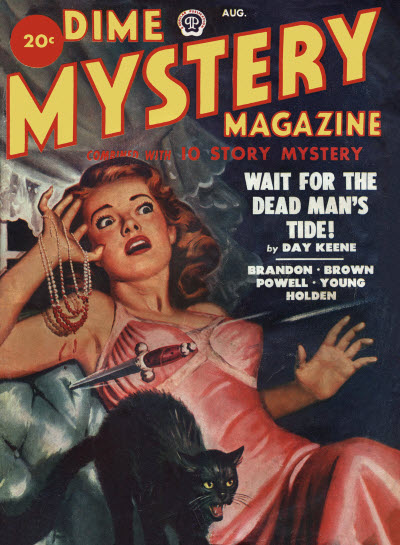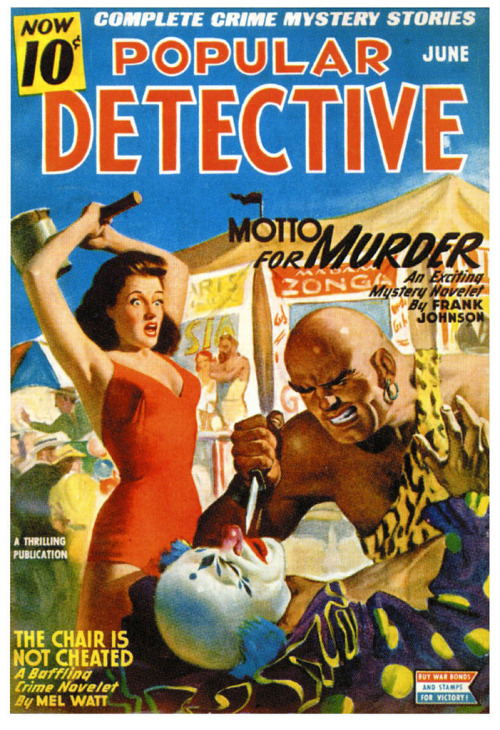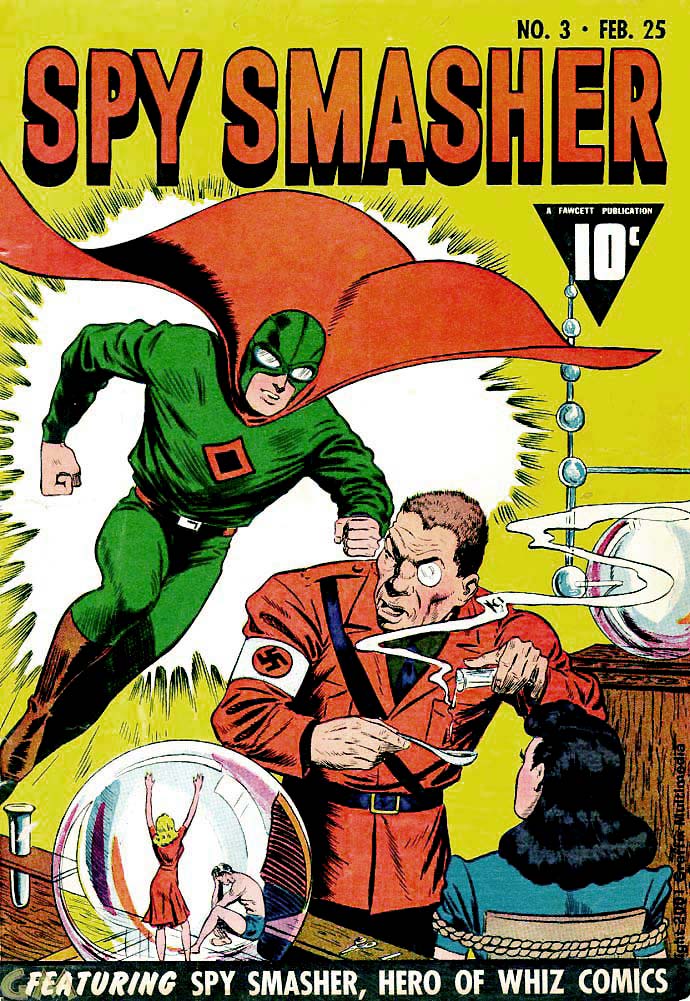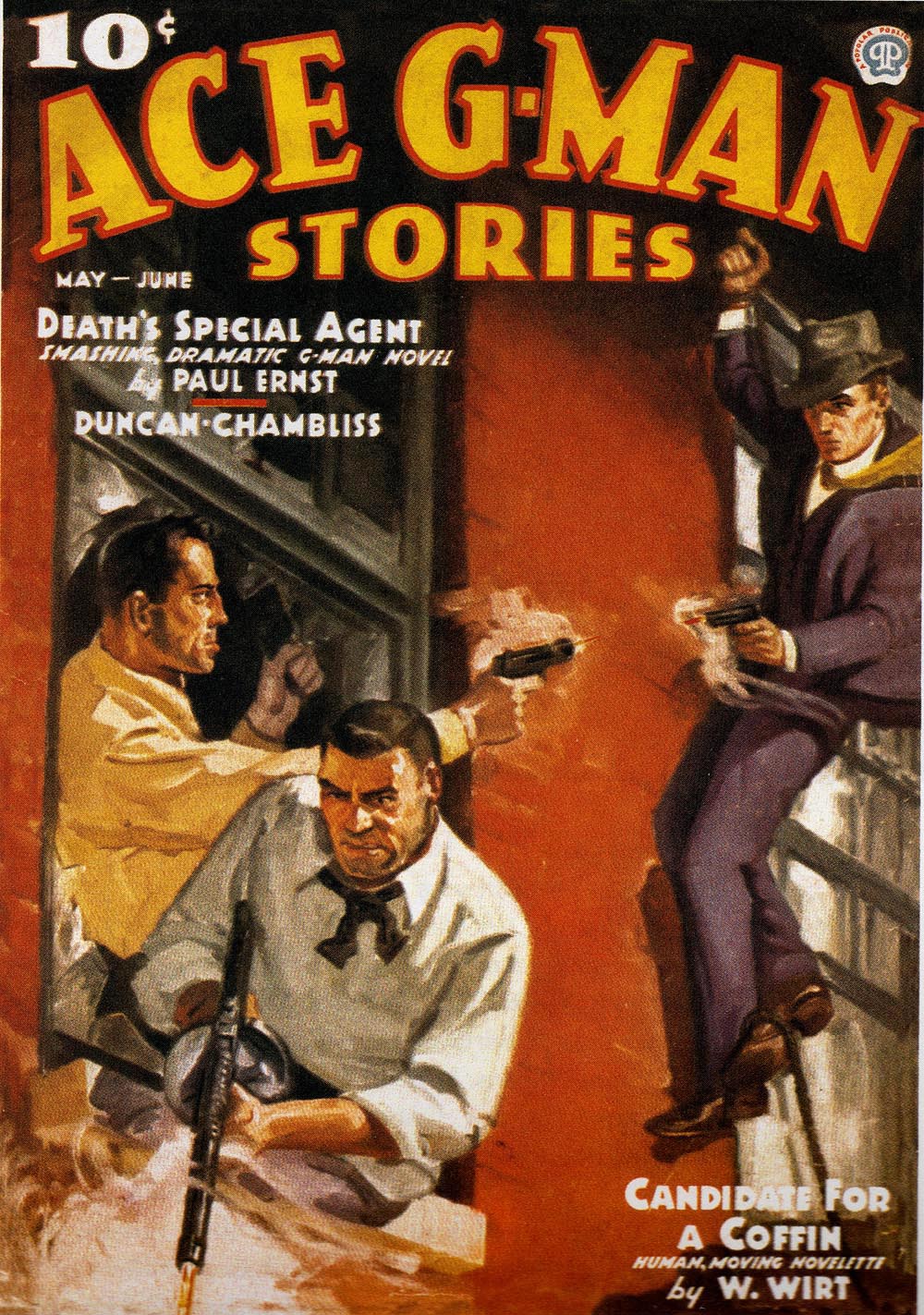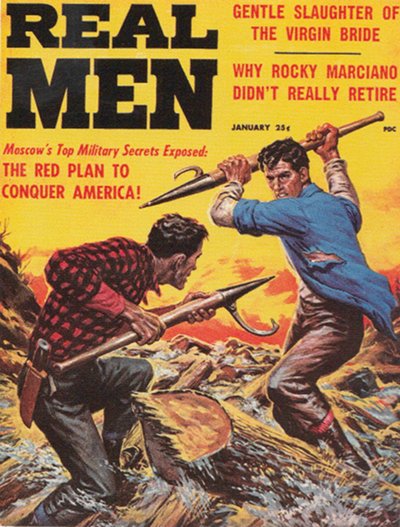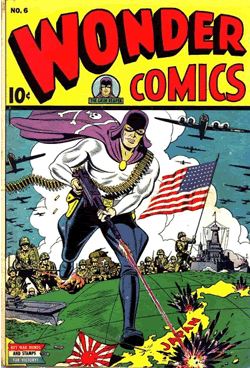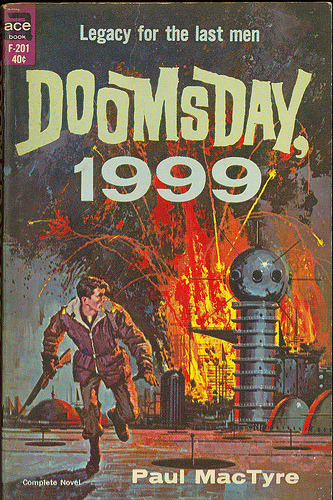Judy and I watched the unrated version of TED (2012) last night. This raunchy comedy/fantasy stars Mark Wahlberg, Mila Kunis and Seth MacFarlane as Ted, the living, talking, foul-mouthed teddy bear. MacFarlane also wrote and directed the film.
TED is part buddy movie, part romantic comedy and, in the third act, part action/adventure movie. There are several very funny scenes that had me laughing out-loud. The special effects are remarkable and I couldn't help but think about the misbegotten HOWARD THE DUCK film from the '80s while watching TED. If CGI technology had been available thirty years ago, maybe HOWARD THE DUCK wouldn't have been such a disaster. Perhaps it's time to consider a remake of that film, given Marvel's film making proficiency and all of the advances in special effects technology since then. After all, a CGI character would be a lot better than a short guy in an atrocious duck costume.
|
Saturday, December 29, 2012
A TALKING TEDDY BEAR?
GANGSTER NO. 1
 |
I watched GANGSTER NO. 1 (2000) yesterday. This bloody British crime film stars Malcolm McDowell as an aged crime boss who, at the beginning of the film, learns that his former boss is about to released from prison. This sets McDowell down memory lane as the action moves to London, 1968 with McDowell providing voice-over narration of his past and his rise to power.
McDowell's gangster character is never given an official name. He's referred to as Gangster No. 1 in the credits (similar to Clint Eastwood's Man-With-No-Name). In the flashback sequence, he's a young thug played by Paul Bettany in the employ of a slick gangster played by David Thewlis. Gangster No. 1 quickly sets out to kill his way to the top and he does so in a series of extremely violent, highly stylized scenes. When Thewlis is sent to prison for a murder that Bettany committed, Bettany assumes full control of the organization and builds it into an empire of crime.
We come back to present day in the third act and it's McDowell, the grizzled veteran, who must face Thewlis upon his release from prison. Things don't go as planned and the ending recalls James Cagney's apocalyptic doom in WHITE HEAT.
GANGSTER NO. 1 is well-made and well-acted but it is extremely violent and laced with profanity. The British accents are a bit hard to understand at times but McDowell delivers a top-notch performance as an irredeemably evil man. If you like hard boiled crime movies, check this one out.
|
HAPPY BIRTHDAY STAN!
Belated birthday wishes to Stan Lee who turned 90 yesterday. Stan Lee is one of my personal heroes and I wish him continued health and happiness and many more birthdays to come.
Like many of my generation, I first encountered Stan in the pages of Marvel Comics in the 1960s. His effusive, bombastic style really connected with me (and millions of other readers). Stan always made it seem like he was speaking directly to the reader, like he was letting us in on something special that he had created just for us. He was a genius at creating troubled protagonists, angst-ridden superheroes with personal problems every bit as compelling and dramatic as that issues' battle with a given super villain. Lee's writing was over-the-top at times and his stories often resembled soap operas with an A-plot line running on top and a B-plot line simmering on the bottom for a couple of issues before becoming the next A-plot with a new B-plot taking its' place. His continued stories assured that we would have to buy the next issue to find out what happened next and you can bet that we did.
Stan was also smart enough to surround himself with top notch artistic, creative talent and the early Marvel bullpen featured such stalwarts as Jack Kirby, Steve Ditko, Don Heck, Dick Ayers, Gene Colan, John Buscema and John Romita (among others). I'm not going to go into who created what and where proper credit is due except to say that Stan had a hand in every Marvel comic book for a number of years as either the writer, editor, writer/editor and finally, publisher.
I adored Stan Lee when I was young. He made me want to become a comic book writer. I never accomplished that goal but he provided me with untold hours of entertainment and escapist pleasure. My brother used to pester me about reading comic books when I was young. He thought they were a waste of time and he used to really get under my skin by telling me that "there is no Stan Lee. That's just a made-up name."
I knew better. Each issue listed the creator credits and there was Stan's name in every issue. Eventually photos of Stan and all of the other Marvel bullpenners ran in a Marvel comic and I had even more proof of his existence as a real-live flesh and blood person. Now, thanks to his cameos in the Marvel movies and other appearances over the years, EVERYONE knows who Stan is, even people who have never read a comic book in their life. My lovely wife Judy (who shares a birth date with Stan), knows who he is and she knows he means as much to me now as he did almost fifty years ago.
'Nuff said and Excelsior!
|
Wednesday, December 26, 2012
HOW I SPENT CHRISTMAS AFTERNOON
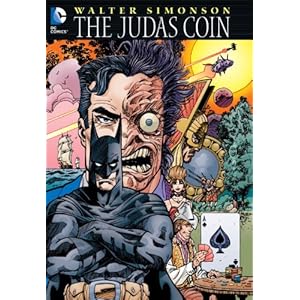 |
For Christmas this year, I gave myself THE JUDAS COIN by Walter Simonson. Actually, I bought it and gave it to Judy for her to give to me on Christmas Eve. I sat down and read it yesterday afternoon.
THE JUDAS COIN is an original hardcover graphic novel written and illustrated by Walter Simonson, one of my favorite comic book artists. The book was published this year by DC Comics.
It's a handsomely produced volume that spans the history of the DC Universe in a unique way. A silver coin paid to Judas for his betrayal of Jesus is the through-line of the novel as the coin passes through various places along the timeline of the DC Universe from the distant past to the far future.
Six disparate characters from the rich history of DC Comics are featured in six short stories that both stand alone and advance the journey of the coin. The featured players include The Golden Gladiator, The Viking Prince, Captain Fear, Bat Lash, Batman and Two-Face and Manhunter 2070.
The real treat here is Simonson's stunning artwork. The art in his Viking Prince chapter is more clearly influenced by Jack Kirby than Joe Kubert, Simonson pays homage to Nick Cardy in his Bat Lash chapter, the Batman/Two-Face chapter is presented in three colors: black, white and red and the final Manhunter 2070 story has manga influenced art (which is an odd choice considering that Mike Sekowsky was the original artist on this character. By the way, I hate manga art.)
THE JUDAS COIN is a fun romp through the fields of the DCU and it's always a pleasure to look at Walt Simonson's art. Reading this graphic novel was a great way to pass a quiet hour on a blustery Christmas afternoon.
|
Tuesday, December 25, 2012
Friday, December 14, 2012
CRAP OUT
 |
I watched COP OUT (2010) yesterday. This was the first Kevin Smith directed film I've ever seen and I can't say that I was blown away.
COP OUT co-stars Bruce Willis and Tracy Morgan as an NYPD detective duo who, although they've been partners for nine years, continue to constantly screw things up. They get temporarily suspended from the force early in the film but work on their own to recover a stolen baseball card from a Mexican drug lord. There's gun play and slapstick and tons of foul language. I admit that I did laugh out loud a couple of times but the film is nothing to get excited about. It's pretty much a by-the-numbers buddy cop action comedy but it's nowhere near as good as such classics as Walter Hill's 48 HRS or Richard Donner's LETHAL WEAPON.
COP OUT is not the worst of this sub-genre I've ever seen. I was entertained while watching it but it's not a film I'll remember nor watch again.
|
Wednesday, December 12, 2012
DOC SAVAGE IMAGE OF THE DAY
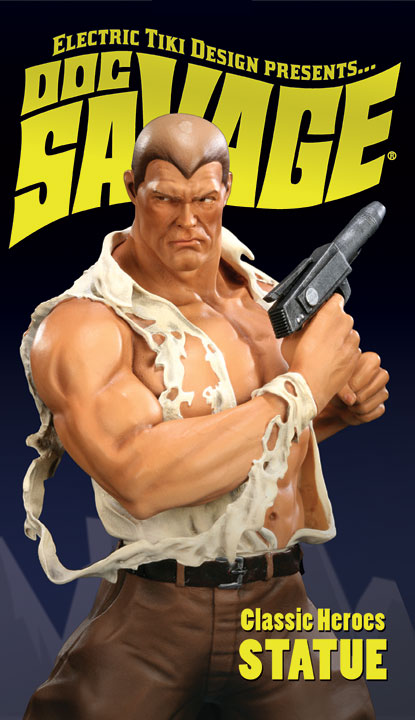 |
Hey Santa! If you're reading this, I'd sure like to find this beauty under the tree on Christmas morning! |
JACK KIRBY ART OF THE DAY
 |
Here's a page from Jack's never published adaptation of the cult British TV show THE PRISONER. |
GOLDEN AGE COMIC BOOK OF THE DAY
 |
PANIC was EC's other humor comic book, a short-lived companion to the immortal MAD. Great Christmas cover by Al Feldstein.
|
SILVER AGE COMIC BOOK OF THE DAY
 |
Iconic cover by Neal Adams from DC's early '70s "reboot" of Superman. |
Tuesday, December 11, 2012
SILVER AGE COMIC BOOK OF THE DAY
 |
Cover art by the great Bob Oskner, who, for my money, drew some of the sexiest women in comics. |
Monday, December 10, 2012
A TALE OF TWO HAWKS
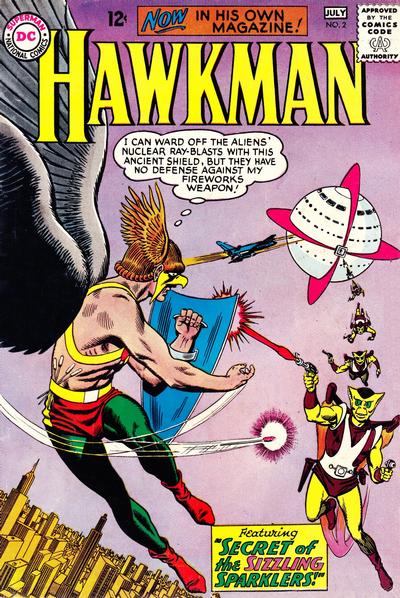 |
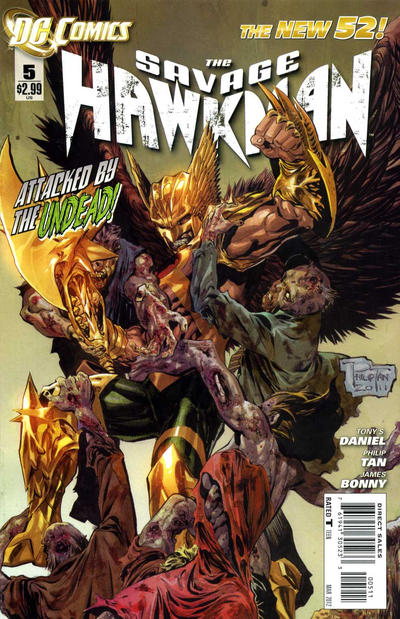 |
I read my comic books in a funny way. First, I'll read an issue of a new comic book, say for instance, THE SAVAGE HAWKMAN #5 published by DC Comics this year and pictured above on the left. Then, I'll follow it up with a back issue from my collection of a similar title or issue featuring the same character. In this case, it's HAWKMAN #2, published by DC Comics in 1964 and pictured above on the right. I hated one of these comics. I adored the other one. Any one care to make a guess as to which is which?
The first issue of THE SAVAGE HAWKMAN was published in 2011 as part of DC's massive relaunch entitled "The New 52". In this iteration of Hawkman (and I've lost track of just how many different versions there have been of this character over the years) finds Carter Hall working as an archaeologist with a special talent for deciphering ancient languages and hieroglyphics. This of course leads to translating material of both arcane and alien origins.
There are only the vaguest hints about Thanagar (Hawkman's home planet in some versions) and no Sheira/Shayera/Hawkgirl/Hawkwoman in any of the issues I've read thus far. Hawkman's Nth metal, in addition to granting him the ability to defy gravity and fly, is now somehow organically fused within Hall's body and manifests itself as overly pointy body armor in times of stress or when Hall needs to become Hawkman.
The issue above is part of a longer story arc, as are almost all modern superhero comics these days and as such, the reader comes into an ongoing story (with little or no editorial help to bring said reader up to speed) and the reader is left with a cliffhanger ending that may or may not be resolved in the next issue. I can't believe that a casual reader, someone with absolutely no knowledge of Hawkman and his incredibly convoluted back story, could pick this issue up, read it and care one whit about ever reading another issue of this comic.
The cliffhanger ends with the reappearance of The Gentleman Ghost, a Hawkman foe who dates back to the Golden Age of comics. He's been updated and modified for this go-round and comes with a slightly new-look and new-powers. Longtime fanboys might be excited by the appearance of this villain in the "New 52" but again, a casual reader is likely to look at this plot development and wonder, wtf?
Hawkman has changed. The Gentleman Ghost has changed. But don't worry. These changes are assuredly not permanent. Once the "New 52" has run it's course (as it most certainly will), at some point in the not too distant future, we'll be treated to yet another rebooting of Hawkman and his gallery of rogues, including The Gentleman Ghost. So enjoy this one while it lasts (if you're so inclined) because I guarantee you, it won't last long.
The artwork by Philip Tan leaves much to be desired. It's dark, muddy, and unclear with unattractive figure work and a clumsy flow from panel to panel. It's hard to look at and hard to follow. Are there no art directors working at DC these days? I suppose the dark art is in keeping with making this new version of Hawkman "savage" aka "dark & gritty" but I'll be honest with you. This isn't a Hawkman I want to read about.
That Hawkman exists in the pages of HAWKMAN #2 from 1964 and yes, I own a copy. This issue sports a terrific cover and interior art by the legendary Murphy Anderson. There are two (count 'em, two) complete stories in this issue and I'm guessing both were scripted by Gardner Fox.
Anderson's art is a thing of beauty to behold. It's clean, simple yet bold, uncluttered and is always, always, always in service to the story. No "look at me, I'm drawing!" gimmicks and stunts here. Just elegant artwork that depicts two superb heroes, Hawkman and Hawkgirl, doing what they do best: fight modern day crime with ancient weapons.
The idea of two alien police officers coming to Earth to study our police methods while also battling evil was and still is a terrific idea. The fact that the Halls eschew their Thanagarian weapons and equipment and take to the skies armed with various weapons from history only adds to the appeal of this series.
Fox's scripts don't focus much on character development. They are problem driven plots in which the Halls (or Hols, to be exact) are confronted by seemingly insurmountable obstacles before utilizing both their brains and brawn to solve the problem and defeat their foes. In the lead story, the Hawks battle alien invaders from another dimension. The tide is turned by the use of sparklers (yes, sparklers!). In the second story, Hawkman fights a gang of crooks using the actual wings of Icarus from Greek mythology.
The artwork is uniformly excellent. Anderson's Hawkman is a bit beefier than the lean, sinewy crime fighter that Joe Kubert drew in earlier issues of THE BRAVE AND THE BOLD, when Hawkman was in try-out mode. Shiera Hall is lovely as is museum employee Mavis Trent and the entire issue is simply a pleasure to read.
So there you have it readers. Which comic did I prefer? Which comic would you prefer? This old geezer says, "they don't make 'em like they used to."
Friday, December 7, 2012
I AM LEGEND
 |
I watched I AM LEGEND (2007) yesterday, yet another DVD I acquired in a trade with one of my collector buddies.
The history of I AM LEGEND is long. The original novel I AM LEGEND by Richard Matheson was written and published in the 1950s. The material was first filmed in Italy as THE LAST MAN ON EARTH (1964) starring Vincent Price. The second iteration was THE OMEGA MAN (1971) starring Charlton Heston. The 2007 version, starring Will Smith, restores the original title but is in reality, more of a remake of OMEGA than a faithful adaptation of Matheson's novel.
If you've seen OMEGA MAN, you're familiar with the basic story. No major changes in LEGEND except that the location is now an abandoned New York City and our hero, Robert Neville has a very smart and loyal dog companion. The special effects are infinitely more elaborate and realistic than what was feasible in the 1970s and make LEGEND a visually interesting film. The action scenes are also ramped up and the "dark seekers", humans who have become vampires, are much stronger and faster than those seen before. There's also a lot more of them and they have vampire dogs as well.
I enjoyed the film even though there are no narrative surprises. Practically everything that happens in OMEGA MAN happens here just on a much bigger scale. It's a good movie but the definitive version of Matheson's novel remains to be made.
|
ASSIGNMENT: THE CAIRO DANCERS
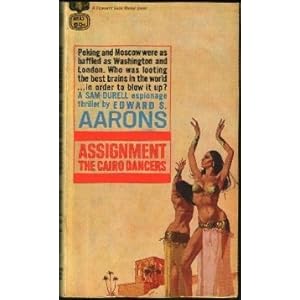 |
I finished reading ASSIGNMENT: THE CAIRO DANCERS (1965) by Edward S. Aarons yesterday. The book is one of the "Assignment" series Aarons wrote starring CIA agent Sam "Cajun" Durell. This long running series (begun in the '50s and finishing in the '80s), was published as paperback originals by Fawcett Gold Medal books.
Sam Durell works for K Section of the CIA. His boss is General McFee who assigns Durell to missions all over the world. Durell globe trots to exotic locales, encounters the requisite beautiful women and evil villains and handles everything with a tough, no-nonsense approach and no high-tech spy-gadgets. The books are tight, fast paced and well plotted. The action moves swiftly and Aarons imbues the stories with a strong sense of place, some nice turns of phrase and good characterization during the course of the adventures.
The Durell "Assignment" series was never picked up by Hollywood for either feature films or as fodder for a weekly television series. The adventures exist only in book form and I've read several of them over the past ten or so years. They're not great literature, but they're fun, quick reads which perfectly capture the Cold War era.
In ASSIGNMENT: THE CAIRO DANCERS, top scientists from many nations have gone missing. One of them is an ex-Nazi (or is he?) expert in the newly emerging laser technology. He's disappeared from Germany where he was betrayed by his daughter. Turns out the scientist is in the hands of The Cairo Dancers, a murderous secret organization that is forcing the captured scientists to construct the ultimate weapon.
The action moves from the beer halls of Munich to the Middle East with an exciting climax in a mountain-top fortress in the Sinai desert where the Dancers plan to unleash a death ray against both Egypt and Israel in an attempt to launch World War III.
ASSIGNMENT: THE CAIRO DANCERS is good, old fashioned '60s spy fiction. Thumbs up.
|
Wednesday, December 5, 2012
SUPERMAN IMAGE OF THE DAY
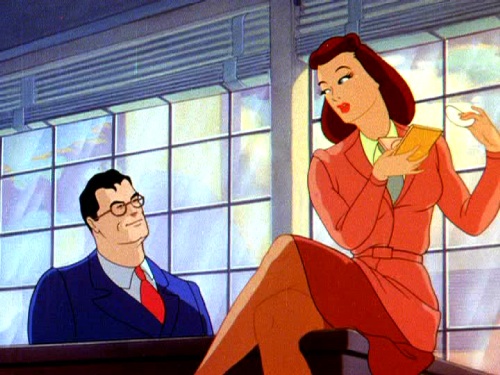 |
Lois and Clark share a quiet moment in the Daily Planet newsroom in this scene from one of Fleischer SUPERMAN cartoons produced for Paramount Studios in the 1940s. If you've never seen these terrific cartoons, you're really missing a treat. I love 'em! |
SILVER AGE COMIC BOOK OF THE DAY
 |
Terrific cover art by the great Carmine Infantino, who is, in my opinion, the greatest FLASH artist of all time. |
VINTAGE PAPERBACK BOOK OF THE DAY
 |
HEADS appears to be a novel about a mad brain surgeon. The sequel was TAILS, a novel about a mad proctologist. |
Friday, November 30, 2012
36 HOURS
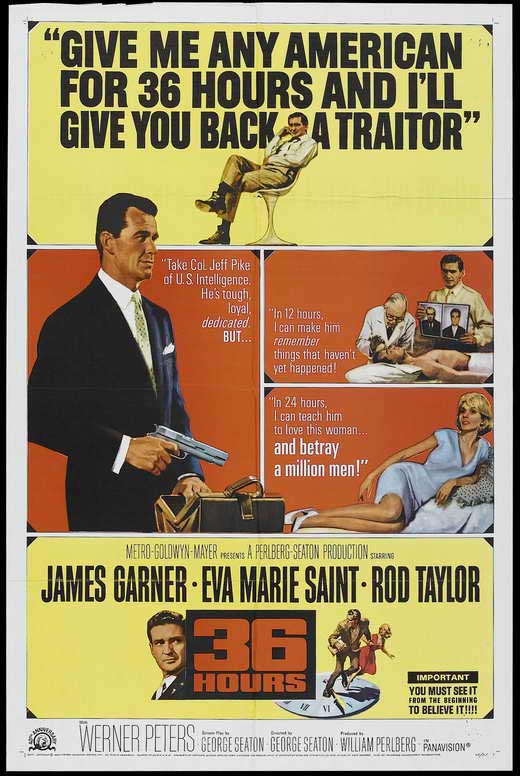 |
I don't recall exactly how I came to own a DVD of 36 HOURS (1965). I figure I got it in a trade with one of my fellow collectors at some point over the years. This is a movie that I was totally unfamiliar with but I sat down and watched it yesterday and I'm glad I did. It's a good one.
This WWII spy thriller stars James Garner as a U.S. military intelligence agent. It's days before D-Day, June 6th, 1944 and the top military brass of the Allied forces want to make the Germans believe the invasion of Europe will take place at Calais instead of Normandy. Garner is dispatched to Lisbon to distribute false information to a German agent. While in Lisbon, the bad guys slip him a mickey and he is whisked away deep behind enemy lines to Stuttgart, Germany.
A U.S. military hospital has been built in Stuttgart that is exact to the last detail. It is populated by English speaking Germans playing the parts of doctors, nurses and patients. While unconscious, Garner's hair is dyed gray, drops are put into his eyes to effect his eyesight and when he wakes up, he finds a newspaper in his room dated May, 1950.
This is all part of an elaborate plan concocted by German doctor Rod Taylor to extract valuable information from Garner concerning the upcoming invasion. If Garner can be madeto think that he's an amnesia victim and that the war has been over for six years, he might freely talk about the invasion, believing that it happened in the past instead of a few days hence. Taylor is aided by Eva Marie Saint, an English speaking German nurse who has been held prisoner in a Nazi concentration camp. Desperate to escape the prison, she agrees to go along with the scheme. Things go well for the Germans until things go wrong when Garner figures out what's really going on.
36 HOURS is a taut, WWII spy thriller that calls to mind several classic MISSION: IMPOSSIBLE episodes in which the victim of the con is made to believe that he (or she) is actually living in a different time and place. It's a fiendishly clever conceit and writer/director George Seaton (who also directed AIRPORT in 1970) handles the action admirably. The three leads are good. Garner is always a pleasure to watch, Saint is solid and Taylor (winner of the Robin Williams look-alike contest) plays a Nazi hating German doctor who cares more about advancing his medical theories for the treatment of shell shock and battle fatigue than in aiding the Third Reich. Several supporting players are better known for their roles on popular television shows of the 1960s including Alan Napier (Alfred on BATMAN), James Doohan (Scotty on STAR TREK) and John Banner (Sgt. Schultz on HOGAN'S HEROES).
The title, 36 HOURS, refers to the amount of time Taylor has to spin out his plan before Garner will be turned over to a menacing SS officer (Werner Peters) who will torture the agent for information.
36 HOURS is a nifty little war film that puts the emphasis on a psychological gambit rather than combat and battle action. Recommended.
|
Monday, November 26, 2012
JACK KIRBY ART OF THE DAY
 |
Simply magnificent two-page-spread by the team supreme of Joe Simon and Jack Kirby from a Golden Age issue of CAPTAIN AMERICA COMICS. |
VINTAGE PAPERBACK COVER OF THE DAY
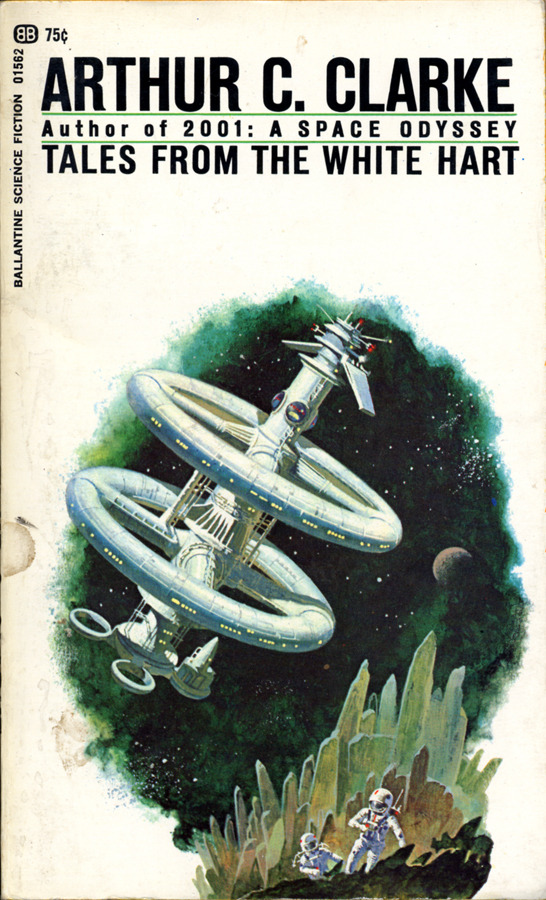 |
After seeing 2001: A SPACE ODYSSEY in the summer of 1968, I became a huge fan of British science fiction author Arthur C. Clarke. I remember buying the book featured above when I was in the seventh grade at O.Henry Junior High. I did a book report on it for my reading class taught by Mrs. Berry. As I recall, there were some pretty good short stories in this book.
|
MEN'S ADVENTURE MAGAZINE COVER OF THE DAY
 |
Terrific artwork by the great Basil Gogos who painted so many memorable covers for FAMOUS MONSTERS. |
Thursday, November 22, 2012
THE KARATE KILLERS
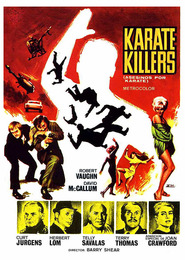 |
Solo: "Do you mind if we look around? We've never been in a real Geisha house." Kuryakin: "Speak for yourself."
I watched THE KARATE KILLERS yesterday, yet another MAN FROM U.N.C.L.E. "movie". This one is really the two-part "The Five Daughters Affair" from the show's third season.
A scientist has come up with a formula for extracting gold from sea water. THRUSH agent Herbert Lom wants it. He kills the scientist and his widow (Joan Crawford in a scene that was probably shot in an hour or less) looking for the formula. Turns out pieces of the formula are in the possession of the scientist's five daughters who are scattered across the globe. Solo and Kuryakin, along with one of the daughters, Sandy (Kim Darby), take off to find the other daughters and the missing information. They're trailed by Lom and his army of assassins, the titular "karate killers".
Along the way, they meet Telly Savalas and Curt Jurgens (two actors who would eventually play villains in James Bond films), British comic actor Terry-Thomas and the lovely Jill Ireland (who was at the time, Mrs. David McCallum before she became Mrs. Charles Bronson). The first part is episodic and lightly played. Once the pieces have been assembled, the clues point to Japan, where everyone heads next. The climax takes place in a THRUSH outpost above the Arctic Circle where Solo and Kuryakin save the day and Lom is covered in gold.
THE KARATE KILLERS isn't bad. There's a great opening sequence involving one-man helicopters attacking Solo and Kuryakin in their sleek, gull wing sports car. The women are fetching (of course) and the action fairly well-orchestrated. It's not the worst MAN FROM U.N.C.L.E. movie but it's no better than average, routine fare. I enjoyed it but I can only recommend it to die-hard U.N.C.L.E. fans.
|
JEALOUS WOMAN
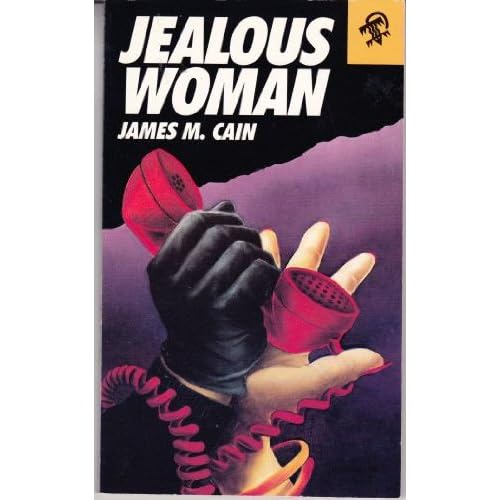 |
I finished reading JEALOUS WOMAN by James M. Cain yesterday. As much as I liked Cain's THE COCKTAIL WAITRESS, I really didn't care for this slight, forgettable mystery novel.
First published in 1950, JEALOUS WOMAN isn't a noir thriller with a doomed protagonist. It's a real mystery novel set in Reno, Nevada involving two insurance agents, two attractive women and two dead men. The most remarkable thing about this story is the appearance of ace insurance investigator Keyes, who played a part in Cain's DOUBLE INDEMNITY. This is a short book (more novella or novelette in length) and it's full of the clumsy dialogue that seems to plague Cain's work. I'm sorry but people just don't talk this way, even in 1950. The mystery is finally solved, the identity of the real killer revealed and there's a happy ending for two of the main characters.
This is far from Cain's best work and is recommended only to absolutely die-hard fans who want to read everything he wrote. It's not bad, just terribly routine and average. I expected and wanted more.
|
Wednesday, November 21, 2012
THE RED MENACE
![[theshadow_07_theredmenace_steranko.jpg]](https://blogger.googleusercontent.com/img/b/R29vZ2xl/AVvXsEimtSTe2kFnP4m4NdGb-T8X9FDwQD1D-49BRvbnbkwbMPq04DiVj4U6PXh7KZgvAgSsL692wLEc2GL_jNys-LtrSiU-VdkSlbDqlwvM3w0hFHaP9rdaxySf0iNvFHatNGyZE3QRcUun9sen/s320/theshadow_07_theredmenace_steranko.jpg) |
I finished reading THE RED MENACE by Maxwell Grant (Walter Gibson) last night. This Shadow pulp novel was originally published in November 1931 and was the fourth Shadow adventure published. The edition I read (shown above) is a Pyramid paperback published in 1975 (when I was a freshman in college). It features a terrific cover by Jim Steranko.
The story finds the Shadow squaring off against a masked villain named The Red Envoy. The Envoy is the leader of a gang of Russian spies who are out to steal the plans for a new weapon (aerial torpedoes) being developed for the U.S. government. The action ranges from the deadly streets of New York where the gang holds secret meetings to the aptly named Death Island, an isolated and menacing hunk of rock in the middle of a Connecticut lake. The finale takes place aboard a train bound for Berlin.
There's action and death traps aplenty and it's nice to see The Shadow leave the confines of New York to battle crime. Too many of his other adventures take place entirely within the city which can get a little old. Doc Savage, my favorite pulp hero, had a nice balance in his stories with the action often beginning in New York and then moving to some other (often exotic) location. Plus, it's nice to see the Shadow fight something other than organized crime (which he often battles). The Russian spy ring and the mysterious crimson-masked Red Envoy are more colorful and interesting than the run-of-the-mill gangsters.
I've read several Shadow novels over the last few years and I do enjoy them. However, I do have a few quibbles. The emphasis in these early stories is on New York based adventures and gangsters. The Shadow's agents, especially Harry Vincent, do most of the work, with the Shadow appearing intermittently in his own adventures. And almost nothing is known about the Shadow at this point in his career. We don't know who he really is nor why he wages his war on crime. I trust that as the series progressed, the Shadow mythos became more fully developed, the locales more varied and the villains more flamboyant and over-the-top. Of the pulp hero series that I've read, I'd rate Doc Savage first, The Spider second and The Shadow third.
Another thing I've noticed is that Gibson often uses the terms "revolver" and "automatic" to describe the same pistol. A revolver is vastly different from an automatic. I don't believe that this was ignorance on the part of Mr. Gibson. I think it's a result of having to crank out an entire, original novel from scratch every month for years and years. There was probably not much time for careful copy-editing and rewriting.
I enjoyed this one and look forward to reading more adventures of The Shadow.
|
Tuesday, November 20, 2012
THE COCKTAIL WAITRESS
 |
I finished reading THE COCKTAIL WAITRESS by James M. Cain yesterday. Cain, for those of you came in late, is one third of the holy trinity of American hard boiled crime writers comprised of himself, Dashiell Hammett and Raymond Chandler. I'll leave it up to you to determine which author represents the Father, Son and Holy Ghost. These three men plied their trade in the pages of the pulp magazines of the 1930s and '40s. They wrote some of the best crime stories of the twentieth century and many of their works have been made into classic films.
Cain had his own holy trinity of pulp fiction with THE POSTMAN ALWAYS RINGS TWICE, DOUBLE INDEMNITY and MILDRED PIERCE. All three are terrific novels and all three have been made into great films (some, more than once and in those cases, it is forever and always the original first versions which remain the best, most definitive adaptations of the source material).
Cain died in 1977 right about the time his body of work was beginning to achieve mainstream recognition and respect. Academics turned their attention to his novels and Cain achieved a measure of immortality as a purveyor of a unique brand of American literature. The majority of Cain's work, despite having roots firmly planted in the trashy soil of the pulp garden, transcended those humble beginnings and is still in print today.
Recently, a "lost" unpublished last novel of Cain's was discovered. The trouble was, this heretofore unknown novel, THE COCKTAIL WAITRESS, didn't exist in just one final form. There were multiple drafts of the work which included different sequences of events, changed names, different descriptions of key scenes, some extraneous material that didn't advance the plot, etc. It fell to editor Charles Ardai (the mastermind behind the extraordinary Hard Case Crime imprint) to shape all of this material into a readable, coherent, linear story. He explains his process in an afterword in the book and I'm here to say that Ardai performed an admirable job. When I was reading the story, I thought it flowed seamlessly. Well done Mr. Ardai. I think James M. Cain would be proud.
The story is narrated by the twenty-one-year old, recently widowed Joan Medford. The action opens at her husband's funeral. His death, she tells us, was an accident and besides, he was a louse who mistreated her and their son and deserved what he got when his car ran off the road and smashed into a culvert.
Joan is left penniless and unable to take care of her son, who goes to live with his aunt, Joan's sister-in-law, who wants to have Joan found unfit so she can keep the child for herself. Joan gets a tip from a sympathetic police officer and soon finds herself hired as a cocktail waitress in a local bar (this despite no previous experience). Joan, it is noted, has a great pair of legs and a body to go with them.
While working in the bar, she meets and serves a regular customer, an older, wealthy man named Earl K. White. Earl falls hard for Joan and she sees a way out of her predicament if she marries the rich old man. But she's also become involved with Tom, a handsome young man who has grandiose dreams of making it big and is also warm for Joan's form.
Through a series of classic Cain plot twists and turns, Joan marries Earl, then loses him when he dies under suspicious circumstances. The police are closing in and she soon finds herself under arrest for the murder of her younger lover, Tom.
However, charges are dropped when an inquest finds "insufficient evidence" against the young woman. She's free to start her life over but is she really? Here's where the brilliance of Cain comes into play. Everything we're told in this story is related to us by Joan who steadfastly maintains her innocence in the deaths of all three men (two husbands, one lover). The question is, is she a reliable narrator, someone that the reader trusts to be telling the truth? Or is she really a scheming murderess who has told her version of the story to cover up and omit certain facts and details and make herself look sympathetic and an innocent victim of misunderstandings and cruel fate? Cain leaves it up to the reader to decide the veracity of Joan's tale. Did she or didn't she?
THE COCKTAIL WAITRESS is a vintage slice of noir pie in which characters get helplessly entwined in webs of their own spinning (to mix metaphors). It's a fast read and I enjoyed the book with one minor quibble.
Cain excelled at plotting and characterization. What he wasn't so good at was dialogue. There are passages in the book that just don't sound right. Words are strung together in ways that no one would ever actually give voice to. The odd language and sentence structure is consistent throughout the book and it's slightly off putting. Also, the text could have used one more pass under the eye of a good copy editor as there are several mistakes of spelling, punctuation and grammar.
Still, a new James M. Cain novel is cause for celebration among genre aficionados. Even if we had to wait thirty-five years, THE COCKTAIL WAITRESS proves that the old master still had it. Highly recommended.
|
Saturday, November 17, 2012
THE SPY IN THE GREEN HAT
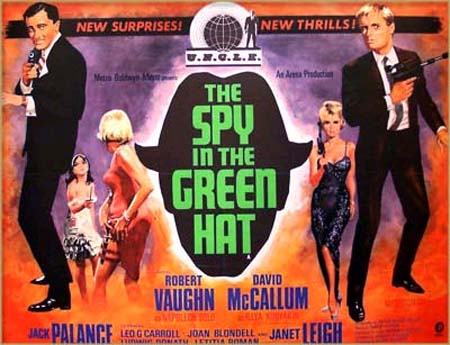 |
| "Look out! It's a pineapple!"
I watched another MAN FROM U.N.C.L.E. "movie" yesterday, THE SPY IN THE GREEN HAT. This was a theatrical release of the two-part, third season episode THE CONCRETE OVERCOAT AFFAIR.
First things first. Is there a spy in a green hat? Yes, although he doesn't appear until late in the film, so at least the title is accurate.
The plot concerns a plan by THRUSH agent Jack Palance to divert the Gulf Stream in the Atlantic Ocean and turn Greenland from an icy wasteland into a lush, tropical "Thrush" land while causing the major cities of the U.S. eastern seaboard to experience flooding and intense snowstorms. Global warming, anyone? He plans to do this by launching missiles from an island in the Caribbean. Don't ask. Palance is aided by Janet Leigh who plays a THRUSH assassin who really enjoys her work. Leigh derives almost orgasmic pleasure from killing. Pretty kinky stuff for a network television series.
Or at least, it would be, if any of this material was played remotely straight. By the time the third season of U.N.C.L.E. hit the airwaves in September 1966, BATMAN had already become a ratings sensation on rival network ABC. The producers of U.N.C.L.E. decided that "camp" was in and the direction of the MAN FROM U.N.C.L.E. took a disastrous turn in that direction, a change that ultimately doomed the series to cancellation.
Along with Palance's plot, Solo and Kuryakin get involved with a family of ancient Sicilian gangsters, the Stiletto brothers. The mobsters are after Solo to make sure he marries their niece (even at gunpoint). The gangsters are broadly played and provide no real threat. They eventually aid Solo and Kuryakin during the climactic raid on the THRUSH island fortress.
Adding immensely to the BATMAN-esque material is the musical score by Nelson Riddle, who scored the BATMAN series. I swear I heard several musical cues that were lifted directly and entirely from BATMAN. It's jinky, strained, faux-heroic fanfares, not the usual "cool" motifs provided by composers Jerry Goldsmith and Gerald Fried.
Palance (never a subtle actor), devours every piece of scenery in sight with an over-the-top, weirdly mannered performance that has to be seen to be believed. Janet Leigh, while still attractive, is a bit old for her role and is definitely slumming. By the way, I met Janet Leigh at a monster movie convention held outside of Washington, D.C. back in 2000. Leigh had just written and published a book about her experiences making PSYCHO. I purchased a copy, got her to sign it for me and she graciously posed for a picture. She was a tiny, lovely lady and I was thrilled to meet her.
THE SPY IN THE GREEN HAT is far from U.N.C.L.E.s finest hour. It's corny, silly and slightly embarrassing and as such, is recommended for die-hard fans only.
|
PASSPORT TO PERIL
 |
I finished reading PASSPORT TO PERIL by Robert B. Parker yesterday evening. This 1951 Cold War spy thriller is a bit of a departure from the usual crime noir material released under the Hard Case Crime imprint but it's a fast paced thriller with plenty of twists and turns.
The author is the original Robert B. Parker, a WWII foreign correspondent who is not to be confused with the late Robert B. Parker who wrote the Spenser series of private detective novels.
In PASSPORT, an American journalist travels behind the Iron Curtain to learn what happened to his brother, an Army Air Force pilot who was shot down during WWII. Our hero, John Stodder, is traveling on the famed Orient Express with a fake passport. He encounters Maria, a beautiful young woman who is on the run from the man who murdered her employer. Turns out that the passport Stoddard thinks is fake is real and belonged to the murdered man. Before you know it, he and Maria are jumping off of the train in the middle of the night and plunging into an adventure involving a die hard Nazi, a deadly femme fatale, Russian officers, unlikely American spies and a must-have envelope containing information about various scientists who worked for the Germans in WWII.
PASSPORT TO PERIL is a brisk spy thriller that is a true product of it's time and place. Parker covered Eastern Europe before, during and after the war and he had first hand knowledge of the the politics, cultures, cities and ways of life he writes about. Great literature? No, but it's a solid piece of intrigue and espionage. Give it a read and see if you don't agree.
|
Friday, November 16, 2012
DINER
 |
| "Does that include the Maryland fried chicken dinner?"
Judy and I watched DINER (1982) the other night. It was the first time she'd seen it. I've lost count of how many times I've seen this film but I hadn't seen it in several years and it was a nice visit with an old friend.
Barry Levinson's semi-autobiographical film recounts a group of young men in Baltimore, 1959. The men are a close knit group. They've grown up together but now, in their early twenties, they're all struggling with different aspects of maturity, responsibility and becoming "adults". They want desperately to hold onto the past while simultaneously taking steps into the unknown future in which each must stand on his own in either success or failure.
The group includes Eddie (Steve Guttenberg), a spoiled mama's boy who still lives at home although he's engaged to be married to a never fully seen woman named Elyse. The marriage hinges upon whether or not Elyse can pass a brutal test of Baltimore Colts football trivia. She fails the test but Eddie goes ahead with the wedding ceremony anyway.
Shrevie (Daniel Stern), is the one married man in the group. His wife (Ellen Barkin), doesn't understand the connection Shrevie has with his buddies. Shrevie, an obsessive-compulsive record collector and music fan, works in an appliance store and seems happiest when he's talking music with the diner guys.
Boogie (Mickey Rourke) is a smooth-talking ladies man who works in a beauty parlor by day and attends law school classes at night. He's also a man with a gambling addiction who finds himself in over his head with debts he cannot pay. He's eventually taken under the wing of Bagel (Michael Tucker), an older diner regular, who pays off Boogie's debts in return for work from the young man.
Fenwick (Kevin Bacon) is an underachieving guy with a drinking problem. Although not formally educated, Fen has more innate knowledge about "stuff" than his peers but he has no drive to apply this knowledge to anything productive and instead lives off of trust-fund money.
Tim Daly is Billy, the only member of the group to leave town for college. He returns for Eddie's wedding and discovers that his platonic girlfriend is now pregnant, the result of a one-night stand in New York. Billy is an earnest young man who is determined to do the right thing.
Modell (Paul Reiser) is the least developed character but he does have several very funny lines ("You know what word I'm not comfortable with? Nuance.").
The final major player in the film is the Fells Point Diner where the guys hang out for late night bull sessions. They smoke, consume plates of french fires with gravy (with a cherry Coke) and relive their glory days. Much of this dialogue was improvised by the actors who spent a lot of time hanging out together and getting to know each other before the cameras ever started rolling.
DINER is a warm, funny, heartfelt coming-of-age film that never becomes overly sentimental. The film has a terrific soundtrack of period rock and r&b songs and the art direction is first rate. The clothes, cars and settings are all authentic and I'd forgotten just how good the film looks.
When Judy and I visited Baltimore last year, I was determined to eat at the Fells Point Diner. The concierge at our hotel swore it was a great place to eat and we hailed a cab and headed off for breakfast one morning. When we arrived at the location (not on the waterfront as in the film but in a dense, urban neighborhood), the diner was long closed and out of business. Someone needs to update their website.
There's a scene in the film in which Boogie is confronted by Tank, a gambling enforcer, outside of the beauty parlor where Boogie works. When I saw the scene this time, I immediately recognized it as a street that Judy and I had walked along near the Walters Art Museum (which was really interesting). Of course, I didn't recognize the street when we were there but I instantly knew it when I saw the film.
DINER had a huge influence on me and my buddies. We saw the film many times over the years and would regularly quote dialogue from the movie. We saw parts of ourselves reflected in the characters and their situations although we did not grow up in Baltimore in 1959. That doesn't matter. What the men in DINER experience is universal.
How big an influence was DINER? Well, when Judy and I were planning our wedding we had a great meeting with our photographer Mark Gaynor. He empathized that he loved to do creative, original, imaginative work, not the standard posed wedding stuff. We were his customers and he would take any pictures we wanted. I asked for two things from him and he delivered.
First, I asked that he photograph all of the groomsmen, ushers and myself in front of Dirty Martin's hamburger joint on the Drag. If any local restaurant would qualify as our "diner" it would be Dirty's. We've been regularly eating there since we were at Austin High in the '70s. Mission accomplished.
Second, I asked if he would do the "DINER shot" (see image above) of the men around the table staring into the camera with blank expressions. He did so and we have that picture (along with others from the wedding) framed and on display in our home. The shot includes myself along with my best pals: the late Ray Kohler, Steve Cook, Terry Porter and Robert "Smiley" Morgan.
How many other people have asked for that iconic image to be recreated as part of the most memorable day of their life? I don't know if there's anyone else out there who had this idea but I do know one thing.
The guys at the diner would be proud.
|
Thursday, November 15, 2012
JACK KIRBY ART OF THE DAY
 |
Here's the Mighty Thor comin' at ya courtesy of Stan Lee, Jack Kirby and Vince Colletta.
In my estimation, Kirby's all-time best and greatest inker was Joe Sinnott. Colletta, on the other hand, didn't always ink everything that Jack drew and sometimes omitted figures, buildings and other background objects. Vince wasn't the best inker in the business but he was apparently one of the fastest and thus, got a lot of assignments on work that had an incredibly short deadline. He inked tons of comic book pages over the course of his life and while he was never my favorite, I must admit that his work seemed perfectly suited to Kirby's pencils on THOR. Not on any other Kirby illustrated title, just THOR. Somehow, for me, that combination worked.
|
VINTAGE MOVIE POSTER OF THE DAY
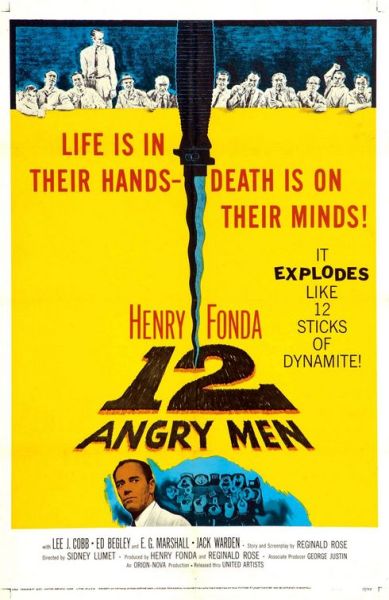 |
Back in the late '80s-early '90s I worked at a video rental store. One day, a customer came in and asked, "do you have twelve angry men?"
"No," I replied. "But we've got a couple of pissed off guys in the back."
|
Subscribe to:
Posts (Atom)



